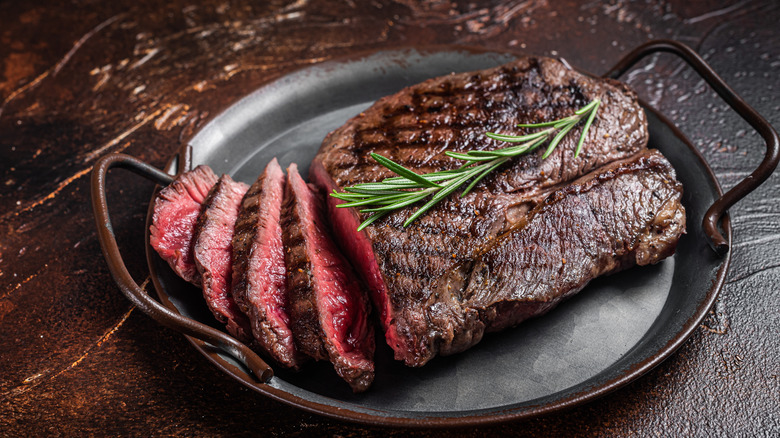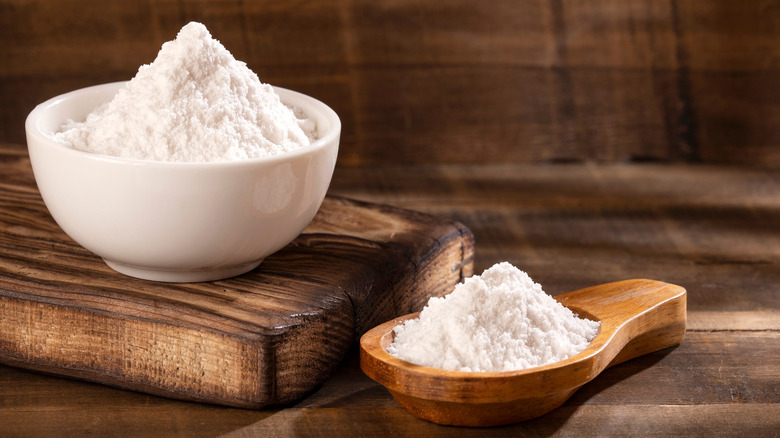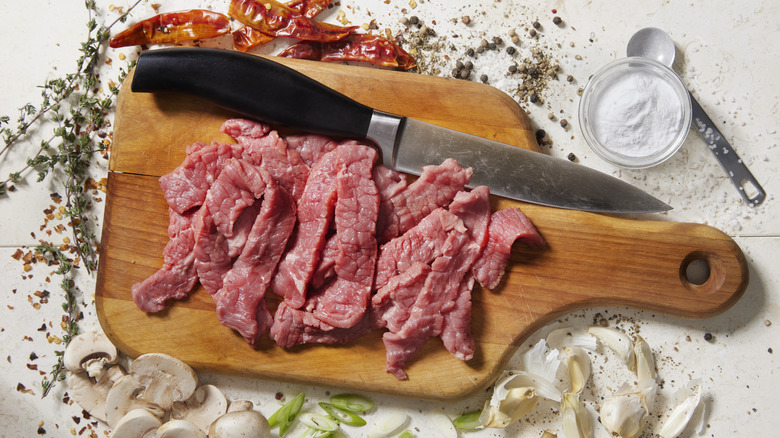How To Use Baking Soda To Tenderize Meat
From marinating to dry brining, a lot of cooking techniques aim to tenderize meat — a process that makes it easier to prepare and cut and also boosts its flavor. The ultimate goal of tenderization, however, is to get better texture, and one of the best ways to do it involves something unexpected: baking soda.
Lots of meat cuts are flavorful, but without tenderization, they can come out tough, chewy, and generally unpleasant. Even naturally softer cuts can benefit from tenderization if the recipe you're making requires thin cuts or high heat, as it mitigates the chances of overcooking. Tenderized steak and chops also absorb marinades and spices more readily, improving their flavor even further.
What makes meat tough are the connective tissues, which are more numerous in cuts like flank steak or pork shoulder. Most of the various forms of tenderizing work by breaking down these tissues and preventing them from tightening up. Tenderization with blades or a meat mallet physically tears these connective fibers apart, while marinades and brines dissolve them using salt, acids, and enzymes from certain ingredients like tropical fruit.
But baking soda tenderizes meat in a different way. Instead of breaking tissues down, the ingredient causes a chemical reaction to occur on the meat's surface, which stops the proteins from seizing up when cooked. This means the meat stays softer and juicier since the tightening that squeezes out liquid doesn't happen. It's the same result as other ways of tenderizing, just via an alternate route.
How to tenderize larger cuts of meat with baking soda
Baking soda is a great option for large steaks or whole chickens because you can let the meat sit for a long time with no risk of breaking the fibers down too much, which can be a problem when using wet marinades. Baking soda works faster than salt too, giving you maximum flexibility — whether you have a few hours for your roast to tenderize, or want to prep it the night before and let it sit without worry.
Start by measuring your baking soda. You only need 1% of your meat's weight in baking soda to tenderize, so convert your cut's weight to ounces, and then measure out 1% of that in baking soda. As an example, one tablespoon of baking soda weighs 0.6 ounces, which is good for 60 ounces, or just under four pounds, of meat. Then, just follow these simple steps:
- Sprinkle the pre-measured baking soda over the meat and rub it onto the exterior with clean hands.
- Put your meat in a non-reactive container (like a zip-top bag or glass bowl) and let it rest in the refrigerator for as short as three hours or as long as overnight.
- When ready, remove the meat from the refrigerator and wash off all excess baking soda with water. Pat dry.
- Cook normally using any recipe you would like.
Remembering to wash off the excess baking soda is crucial. It has already worked its magic, and anything leftover could lend an unpleasant flavor to your meat.
How to tenderize smaller cuts of meat with baking soda
Baking soda also works well with smaller cuts of meat, since the larger exposed surface area needs less time for the ingredient to work. This technique is popular when making Asian stir-fries, which uses a process called velveting to tenderize thin strips of meat. Velveting can use baking soda or cornstarch, and involves making a slurry for a short marinade before cooking. You can also mix baking soda with marinade ingredients like soy sauce instead of water to both tenderize and flavor the meat.
For 12 ounces of sliced meat like chicken or beef, you'll want a teaspoon of baking soda. If you are cooking very small pieces like ground beef, just ¼ teaspoon will do. If you plan on also marinating the meat with other ingredients that tenderize like citrus juice or soy sauce, you can cut the amount of the baking soda in half. Then, follow these directions:
- Make a slurry mixing ½ cup of water or marinating liquid with your baking soda for each 12 ounces of meat.
- Mix your pieces of meat with the slurry and let it sit in the refrigerator for 15 to 20 minutes. Up to 45 minutes is fine if you need.
- Remove meat from the slurry, wash off, and pat dry.
- Cook as called for in your recipe.
Whether it's small strips or a whole steak, baking soda can be your ticket to the most tender meat of your life.


